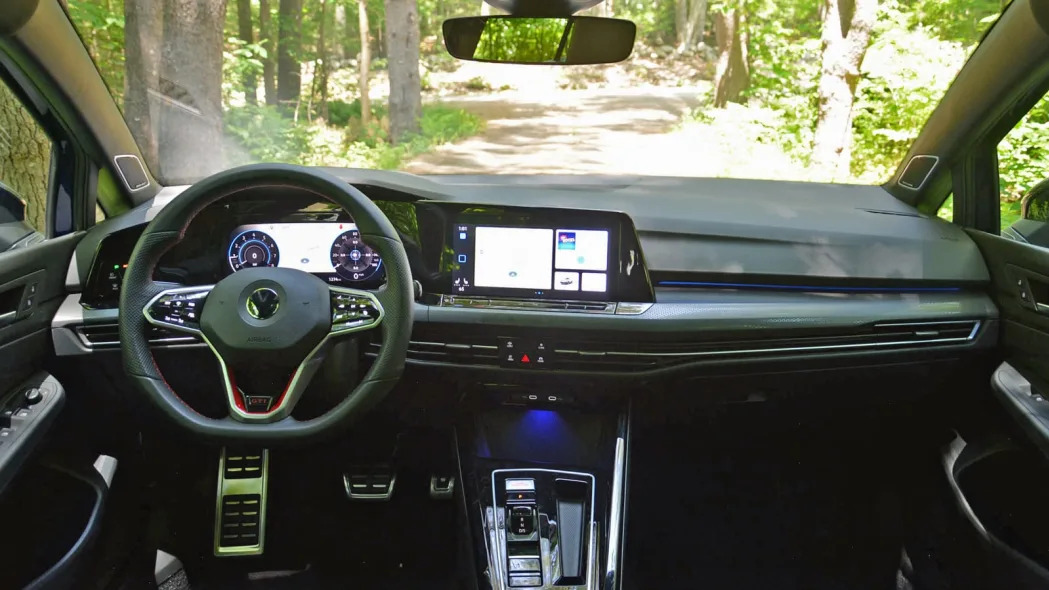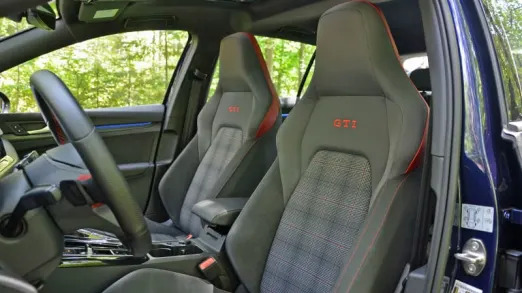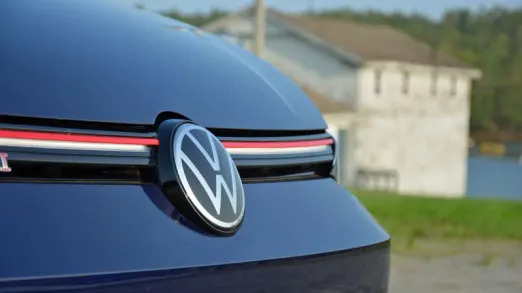BOSTON -- Someone well-versed in automotive history could turn the GT nameplate into an upper-level college class. Race down memory lane and you’ll discover the various suffixes that have been attached to it: GTA, GTB, GTC, GTD, and GTE are among the variations of the gran turismo theme, and each one means something different. GTL? That’s the Renault 4 with the “big” engine (34 horsepower!). GTO? That’s the classic Ferrari worth a small country’s GDP. Or, you know, a Pontiac.
GTI appeared on anything from a Citroën BX to a Nissan Sunny in the 1980s before fading away. Reverse up memory lane to 2023, and Volkswagen’s global range stands proud as the GTI name’s last bastion. I took a GTI on a trip from Boston to Mid-Coast Maine to find out how the nameplate represents the gran turismo today.
It took only a handful of miles to realize that my plan to beat rush-hour traffic out of the Boston area was as optimistic as trying to race the sun. But, in hindsight, crawling toward Maine one car length at a time gave me the opportunity to familiarize myself with the eighth-generation Golf GTI’s interior layout.
My colleagues have extensively covered Volkswagen’s current infotainment system, and I’m not going to rehash their thoughts; I agree that the user interface, which is dominated by awkward touch-sensitive surfaces, is as well-cooked as steak tartare. Volkswagen seemingly agrees, because a complete overhaul that will include software updates and bring back at least a small handful of buttons is around the corner (although it won't arrive soon enough to save the revised Atlas).



However, it’s worth separating the user interface and the software because there are some pretty good features lurking in the 10-inch touchscreen. It offers sharp-looking graphics, I don't find it difficult to navigate, and I like the ability to show different functions (such as navigation directions and radio options) on the same screen – it saves you the time and trouble of having to exit the navigation widget to find a song.
Beyond the infotainment system, the GTI’s interior feels like a digital remix of the last-generation model's. It remains driver-focused, but the horizontal lines on the dashboard make the cabin appear much wider, and the overall layout isn’t as analog. Despite all the buttons that Volkswagen plucked out, a handful of new switches elbowed their way onto the center console. The automatic gearbox’s shifter is now a small, razor-like device that almost feels like a Porsche 911’s, and the parking brake is electronic.
The driver faces a 10.25-inch digital instrument cluster that can display a stunningly wide selection of data, ranging from basic metrics like the car’s speed and the engine’s revolutions to a g-force meter. The rear passengers face, well … the front seatbacks, but there’s a cool feature back there as well. Rather than adding storage nets, which tend to sag over time, Volkswagen fitted clever phone-sized pockets.
As traffic gradually thins, a forest of “LIQUOR STORE” signs inform me that I’m about to cross the New Hampshire border. “Live Free or Die” has seemingly become interchangeable with “Drink Free or Die” in the Granite State, and should I have been so-inclined, there would in theory be enough space for a booze run in the 19.9-cubic-foot cargo area despite two small suitcases already back there. Instead, the day’s mission is simply to reach my destination at a reasonable hour.
“Watch for moose” signs are an indication that my short trip through wine outlet country has come to an end, and traffic becomes appreciably more fluid as I drive deeper into Maine. Since leaving Boston, I’ve spent most of my time in the GTI on I-95, with the adaptive cruise control set to whatever speed seems doable. It’s fine in these conditions: my test car is equipped with the seven-speed dual-clutch automatic transmission, which certainly takes a great deal of effort out of driving in stop-and-go traffic. Even at 80 mph, the GTI is not overly loud. You can hear the engine, as you should in a hot hatch, but you can still talk.

Route 1 leads me to the type of twisty, fast-paced back roads that Volkswagen developed the GTI for, and Maine isn’t exactly flat, which dials up the fun factor. Power for the current-generation car comes from an evolution of the last GTI’s turbocharged, 2.0-liter four-cylinder engine, which develops 241 horsepower at 5,000 rpm and 273 pound-feet of torque at a low 1,600 rpm. Forget the 0-60 time. The GTI peddles a type of engaging driving fun that can’t be distilled into numbers, and it does this by sticking to a tried-and-true formula: front-wheel-drive and a suspension pegged on the sporty side of comfortable.
Turn after turn, the GTI reminds you that driving isn’t the four-wheeled equivalent of doing the dishes. It’s not as hardcore as some of its more analog predecessors; it feels more polished than even the last-generation GTI, but it remains the type of car that immediately puts a smile on your face. There are plenty of viable options if you’re in the market for a fun car, but unlike the Subaru BRZ, for example, you’ve got good visibility and the practicality you expect from a four-door hatchback.
On a secondary level, the GTI reminds you that a car doesn’t need headline-grabbing power figures to put a smile on your face. If I toss you the keys to a 602-horsepower Lamborghini Huracán Evo, you’re going to have the time of your life, but you’ll likely break every traffic rule in the book (including a few you’ll probably discover while reading the ticket) before you reach even half of the car’s potential. With “merely” 241 horsepower under your right foot – that’s less than some minivans! – the 3,200-pound GTI lets you explore more of its performance spectrum without needing to book a few laps at the local track.
There’s some torque steer under heavy acceleration, but it’s not alarming or overwhelming; it’s actually pretty entertaining once you learn how to master it. There’s not a ton of turbo lag, the engine delivers linear acceleration, and the dual-clutch automatic certainly fires off quicker shifts (on its own or via the paddles) than a human could. Is that the point, though? On a track, sure, every second counts. On an open road, however, there’s not a dude waiting for you with a checkered flag, a stopwatch and hopefully a trophy. While the dual-clutch arguably makes the GTI a more comfortable daily driver, that ease comes at the expense of engagement. I’m admittedly part of the "#SaveTheManuals” crowd — I’ve lived in Europe for most of my adult life and I haven’t owned an automatic car in years — but I’m not alone: As rivals gradually ditch the stick, Volkswagen keeps it around because the take rate among GTI buyers hovers around 40%.
While you’re hauling ass going left, right, up and down as you mentally debate the pros and cons of a stick-shift, the folks enjoying the evening air on colorful Adirondack chairs just see a little blue hatchback. The beauty of it is that, at its core, it’s a Golf.




One aspect of the Golf GTI recipe that hasn’t changed much since the first-generation model went on sale in Europe in 1976 (and in the United States, as the Rabbit GTI, for the 1983 model year) is design. Subtle red accents and a more muscular-looking body kit were the main exterior details that separated the first Golf from the first GTI; Volkswagen wisely chose not to add jumbo scoops and wings. This low-key approach to design characterizes the eighth-generation model as well. Folks who can name a car’s engine code faster than their zip code certainly know what they’re looking at, but I’m not convinced the average driver realizes what a GTI is, let alone knows what makes it more special than a standard Golf. That was certainly the case in the Maine where the GTI hardly turned a head.
And then, there’s pricing. Volkswagen charges $31,625 (including a $1,095 destination charge) for a base 2023 GTI S with the six-speed manual transmission. My test car, a mid-range SE trim, checked out at $37,225 including the aforementioned destination charge, which is stunningly reasonable given the significant increases we’ve seen in every corner of the industry over the past few years. While the term “good deal” is highly relative, even a base GTI offers a highly appealing bang-for-the-buck proposition.
On the surface, “GTI” is just another nameplate that gets pelted your way via various forms of marketing. Dig deeper and you’ll find that these letters have represented the same values since 1976: performance, practicality and affordability. We’ve seen variations of this concept, the MKIII and MKIV cars offered a VR6 engine, but the big picture hasn’t changed for nearly 50 years. That’s why Volkswagen still sells the GTI after many of its rivals quit the segment, and why the model remains the quintessential hot hatch.
Just get it with a stick.
Related video:













Sign in to post
Please sign in to leave a comment.
Continue